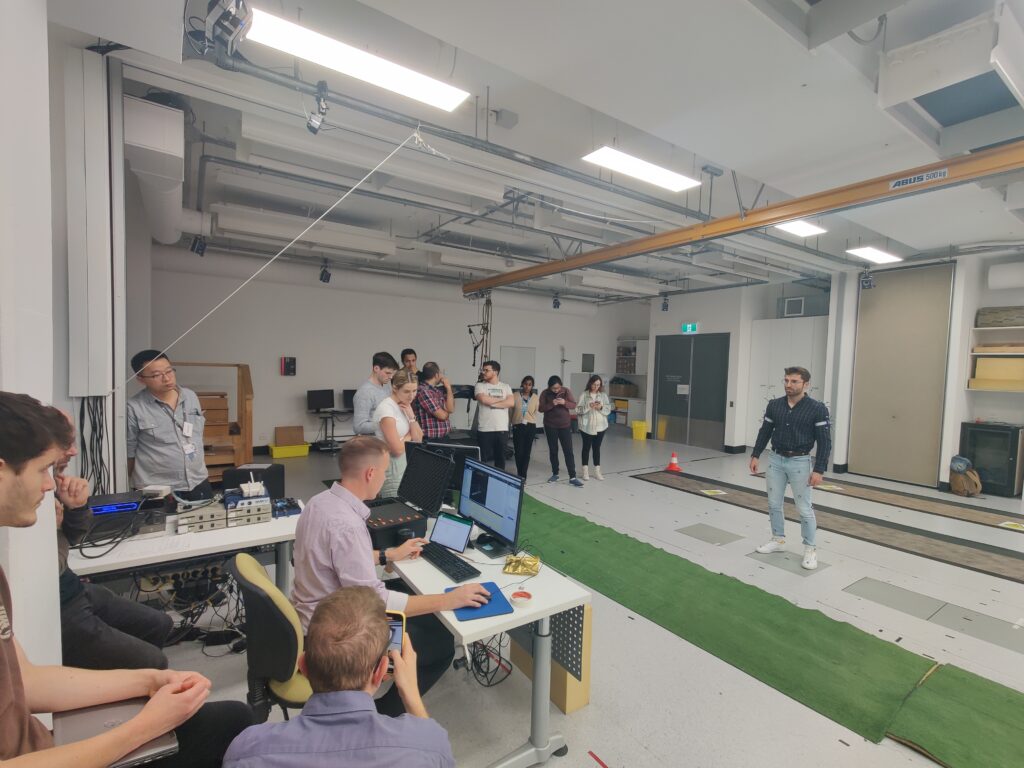Industry Training sets Centre Students Apart: Logemas Vicon/Vero Workshop – 6/6/2023

On Tuesday the 6 of June Dr Denny Wells and Scott Brennan from Logemas delivered a workshop on basic and advanced skills in VICON for the centre students at the Institute of Health and Biomedical Innovation (QUT, Kelvin Grove campus).
Logemas is Australia’s foremost motion capture and measurement technology company, which in collaboration with the centre is working to assess the neuromechanical function of upper limbs in pre-surgical and post-surgical populations, develop new wearable technologies for optimizing functional movement, and develop VR technologies for rehabilitation.
VICON software is a market-leading motion capture tool with accurate algorithms and robust real time tracking of movements from marker data. The tool is essential to the work of the centre under Program 4, led by Prof Graham Kerr with support from postdoc Wolbert Van Den Hoorn, for in vivo assessment of upper limb movements, physiology and rehabilitation as we capture movement data and assess range-of-motion from different patient cohorts.
Photo: Centre PhD student Mr Francois Bruyer Monteleone positions himself in front of the motion-capture cameras to explore more complex models available in Nexus and to help calibrate different skeleton models for different data sets.
The software works by an estimated 3D human pose from multiple synchronized 2D camera views using deep learning algorithms to capture movement effectively. This is a contrast to Traditional motion capture systems require attaching markers to specific points on the body, which can be time-consuming and restrictive. The developments from Logemas and Dr Denny Wells with markerless motion capture technology eliminate the need for physical markers, allowing for a more streamlined and intuitive approach to capturing movement with his talk ‘A Practical Guide to Markerless Motion Capture’ respectively.’
The basic workshop covered the system configuration set up needed for capturing data. It also detailed the system hardware from the camera all the way through to the software interface. With a focus on how to set up the system for optimal calibration and reconstruction of marker data. It further covered some of the most common problems encountered in Nexus and how to resolve the problem (Troubleshooting FAQ).
The Advanced workshop went into depth on icon Nexus which has a wide range of analysis features available. This showcased more complex models available in Nexus (CGM2 / SCoRE SARA) encouraging participants from the centre to customise skeletons of their own projects. This facilitated focused learning of software that could be used directly on research and provided the opportunity to ask questions on specific functions from the experts.
The workshop also explained the integration of other analysis platforms such as Matlab and cover IMU sensor integration with Vicon. Matlab, being widely used at the centre and within the field, was incredibly valuable to learn integration methods for biomechanics research.
Overall the centre Highly values the partnership with Logemas to deliver exceptional training and development opportunities to ensure our students are industry ready.
The centre is proud to announce several projects at the centre use Logemas’ technology as their preferred motion capture methods:
Program 4: In vivo assessment of upper limb movements, physiology and rehabilitation
4 projects
- Arthur Fabre’s PhD entitled ‘A Wearable Magneto-Inertial Measurement Units-Based System for the Upper Limb and Shoulder Kinematics Assessment,’ specifically his research tasks on developing and validating IMUs, and creating a database of IMU / Vicon 3D / Shoulder muscle EMG for upper limb movement.
- Giacomo Nardese’s PhD entitled ‘Neurophysiological adaptations to shoulder injuries: cortical function of shoulder muscles and motor control implications’ work on brain muscle interactions during upper limb movements.
- Eric Su (postdoc’s) work on understanding role of shoulder muscle afferents in controlling upper limb movements.
- Zimmer Mymobility project, CI: Dr Wolbert van den Hoorn
Program 1: in silico upper extremity modelling and simulation
2 projects:
(1) PhD project ‘Investigation on patient-specific features of shoulder MSK modelling. Study of an MRI-based EMG-driven model’ (completed early 2023) on shoulder musculoskeletal modelling using personalised shoulder kinematics and EMG data, with 3 publications published:
- Lavaill, M., Martelli, S., Gilliland, L., Gupta, A., Kerr, G., & Pivonka, P. (2022). The effects of anatomical errors on shoulder kinematics computed using multi-body models. Biomechanics and Modeling in Mechanobiology, 21(5), 1561–1572. https://doi.org/10.1007/s10237-022-01606-0
- Lavaill, M., Martelli, S., Kerr, G. K., & Pivonka, P. (2022). Statistical Quantification of the Effects of Marker Misplacement and Soft-Tissue Artifact on Shoulder Kinematics and Kinetics. Life, 12(6), 1–11. https://doi.org/https://doi.org/10.3390/life12060819
- Lavaill, M., Martelli, S., Cutbush, K., Gupta, A., Kerr, G. K., & Pivonka, P. (2023). Latarjet’s muscular alterations increase glenohumeral joint stability : A theoretical study. Journal of Biomechanics, 155(May), 111639. https://doi.org/10.1016/j.jbiomech.2023.111639
(2) Ultrasound precision tracking (seed grant project), CI: Dr Dermot O’Rourke
And we look forward to further collaboration and training opportunities with the Logemas team in 2024.
